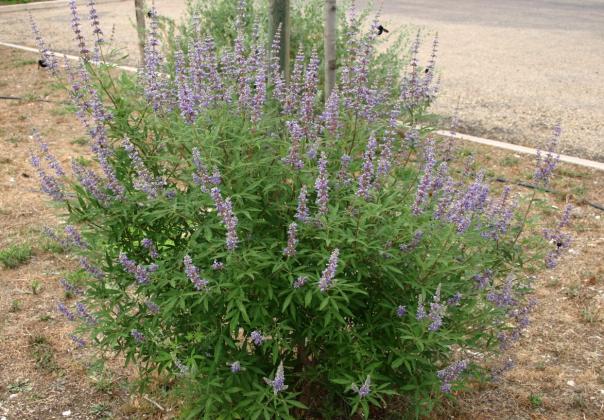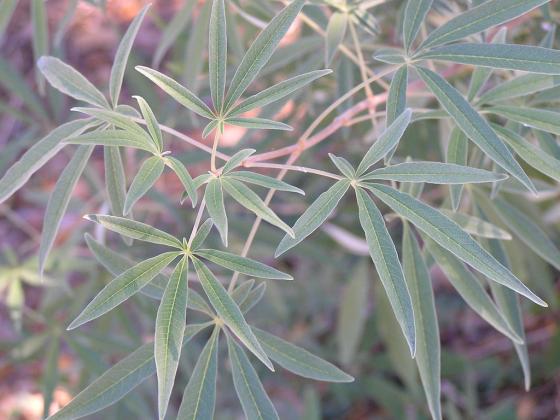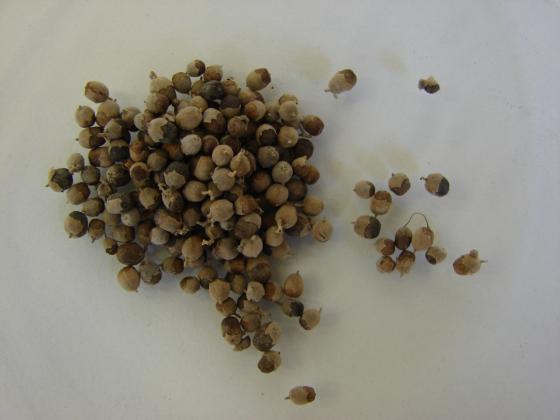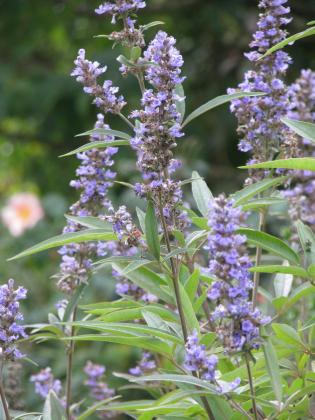Vitex agnus-castus – Perfume, honey, medicine, highway medians

Vitex agnus-castus, vitex, is native to Asia and the Mediterranean region. Now common in Grimes County landscapes, it’s believed that vitex came to North America in the 17th century. It is easily recognizable because of its spikes of showy, purple flowers. Bees, butterflies and other insects enjoy the nectar which produces excellent honey. It is usually from 3 to 10 feet tall and may be as wide with twisty multiple trunks. Leaves are olive green and palmately compound. Flowers and leaves are aromatic. Dark brown fruit is a drupe, berry-like. Beautiful and hardy, vitex is prized as a long-lived cut flower. The Texas Department of Transportation, txdot.gov, has recommended it for plantings in the median of some state highways.
Vitex is from the Latin vieo, to weave, as it was used to make baskets. Agnus-castus is from the Latin agnus, lamb, and castitas, chastity. For millennia the plant has been used for reproductive health and to promote celibacy. This explains many of its common names such as chasteberry and monk’s pepper.
One of the earliest written references is from the Greek physician Hippocrates (c.460 — c.370 BCE). He recommended vitex for injuries, inflammation, as a help for women during childbirth, etc.
Dioscorides (c. 40 — 90 CE), a Greek physician, botanist and Roman army surgeon wrote about vitex. He is the author of De Materia Medica which for about 1500 years was the primary physicians’ reference. For soldiers’ wives waiting for their husbands who were away fighting, he advised a vitex beverage. It was also suggested for the soldiers. He recommended the plant for many conditions and it is interesting that modern studies are often in agreement with Dioscorides. Following are a few of many articles referencing V. agnus-castus:
• National Institutes of Health, NIH, ncbi.nlm.nih.gov, “Herbal fertility treatments used in North America from colonial times to 1900, and their potential for improving the success rate of assisted reproductive technology."
• NIH, “The treatment of premenstrual syndrome with preparations of Vitex agnus castus: a systematic review and meta-analysis.”
• NIH, “A Vitex agnus-castus extract inhibits cell growth and induces apoptosis in prostate epithelial cell lines.”
• European Medicines Agency, ema.europa.eu, “European Union herbal monograph on Vitex agnus-castus L., fructus, Final.”
• The World Health Organization, who.int, “WHO Monographs on Selected Medicinal Plants Volume 4.” Search for documents at apps.who.int/medicinedocs/en/p/download.
• The German Commission E, Germany’s scientific advisory board, has approved vitex for certain women’s issues. The English translation is at the American Botanical Council, cms.herbalgram.org/expandedE. Search for “chaste tree fruit.”
Furniture was made with vitex branches. Fruit and leaves are used as a spice and are one of the ingredients in the Moroccan spice mixture ras el hanout. Yellow dye is made from the leaves and perfume is made from the flowers. Essential oils from the plant are being studied for their antibacterial and sedative effects. The plant is available in herbal mixtures in stores and online in various forms.







